
Hang gliding is an air sport or recreational activity in which a pilot flies a light, non-motorised, fixed-wing heavier-than-air aircraft called a hang glider. Most modern hang gliders are made of an aluminium alloy or composite frame covered with synthetic sailcloth to form a wing. Typically the pilot is in a harness suspended from the airframe, and controls the aircraft by shifting body weight in opposition to a control frame.

A fixed-wing aircraft is a heavier-than-air aircraft, such as an airplane, which is capable of flight using aerodynamic lift. Fixed-wing aircraft are distinct from rotary-wing aircraft, and ornithopters. The wings of a fixed-wing aircraft are not necessarily rigid; kites, hang gliders, variable-sweep wing aircraft, and airplanes that use wing morphing are all classified as fixed wing.

Ultralight aviation is the flying of lightweight, 1- or 2-seat fixed-wing aircraft. Some countries differentiate between weight-shift control and conventional three-axis control aircraft with ailerons, elevator and rudder, calling the former "microlight" and the latter "ultralight".
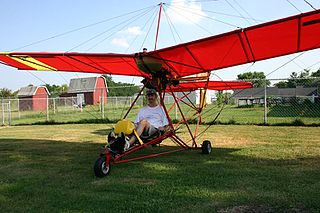
Quicksilver is a line of single and two-place high wing, single-engine, ultralight aircraft that evolved from weight-shift hang gliders including Bob Lovejoy's High Tailer.

Hang gliding is an air sport employing a foot-launchable aircraft. Typically, a modern hang glider is constructed of an aluminium alloy or composite-framed fabric wing. The pilot is ensconced in a harness suspended from the airframe, and exercises control by shifting body weight in opposition to a control frame.
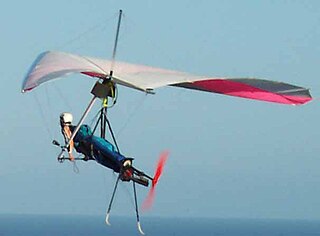
A foot-launched powered hang glider (FLPHG), also called powered harness, nanolight, or hangmotor, is a powered hang glider harness with a motor and propeller often in pusher configuration, although some can be found in tractor configuration. An ordinary hang glider is used for its wing and control frame, and the pilot can foot-launch from a hill or from flat ground, needing a length of about a football field to get airborne, or much less if there is an oncoming breeze and no obstacles.

A glider is a fixed-wing aircraft that is supported in flight by the dynamic reaction of the air against its lifting surfaces, and whose free flight does not depend on an engine. Most gliders do not have an engine, although motor-gliders have small engines for extending their flight when necessary by sustaining the altitude with some being powerful enough to take off by self-launch.

The UltraFlight Lazair is a family of Canadian designed and built twin-engine ultralight aircraft that were sold in kit form between 1979 and 1984.
Barry Hill Palmer is an American aeronautical engineer, inventor, builder and pilot of the first hang glider based on the Rogallo wing or flexible wing. Palmer also designed, built and flew the first weight-shift ultralight trike aircraft.
Raj Hamsa Ultralights is an Indian private limited company and ultralight aircraft manufacturer, founded in 1980 at Pondicherry, India by Joel Koechlin of France. The company is one of India's largest aircraft manufacturers and is the only producer of commercial microlight aircraft. It started in 1980 producing hang gliders, introduced powered hang gliders in 1983 and the X-Air line of microlights in 1993. By 2007, the company had produced over 1,000 aircraft.

Aircraft Sales and Parts (ASAP) is an American kit aircraft and parts manufacturer, founded in Vernon, British Columbia and moved to Sealy, Texas in 2013 and renamed the Aeroplane Manufactory. In 2023 the Aeroplane Manufactory sold it's inventory and aircraft production rights to Legacy AIR1.
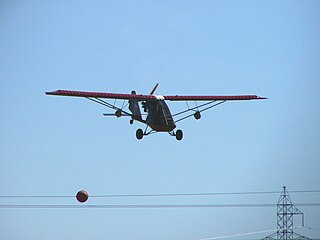
The Birdman Chinook is a family of single and two-place, pusher configuration, high-wing ultralight aircraft that was first flown on 12 December 1982 and produced by Birdman Enterprises of Edmonton, Alberta, Canada, starting in 1983.
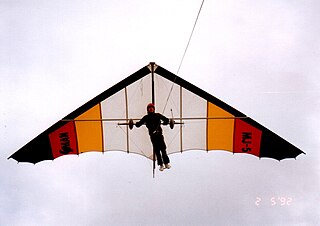
Birdman Enterprises Limited was a Canadian aircraft manufacturer that commenced business in 1973 and became well known for its line of hang gliders and later its ultralight aircraft until its demise in late 1987.
The Airdrome Dream Classic is a minimalist, high wing, single seat, single engine ultralight aircraft inspired by the 1908 Santos-Dumont Demoiselle and produced in kit form by Airdrome Aeroplanes of Holden, Missouri.
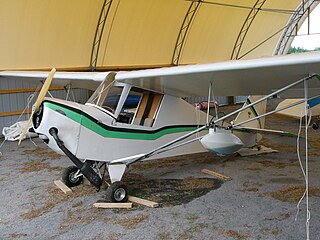
The Fisher FP-101 is an American single-seat, high-wing, conventional landing gear, tractor configuration single engine ultralight aircraft that was available in kit form from Lite Flite of South Webster, Ohio and later Fisher Flying Products of Edgeley, North Dakota.
The Birdman Project 102, also known as Windsoar, was an experimental high wing, single engine, pod-and-boom, conventional landing gear-equipped, ultralight motor glider originally intended for production by Birdman Enterprises.
The Birdman Atlas is a single-seat, high wing, single engine in pusher configuration, ultralight aircraft that was based upon the Eipper Quicksilver design.

The CGS Hawk is a family of high wing, strut-braced, pusher configuration, single and two-seats-in-tandem ultralight aircraft, designed by Chuck Slusarczyk and manufactured by CGS Aviation.
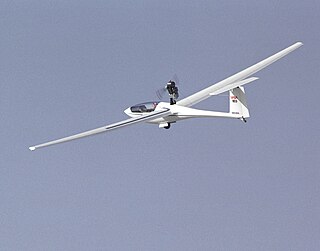
Polyteknikkojen Ilmailukerho (PIK) is the student flying club of the Aalto University. As well as a flying club, it develops light aircraft and gliders, often on a small scale but sometimes its designs have been produced in quantity. Approximately 536 aircraft have been built by the organisation and its sub-contractors. It is similar to the Akafliegs of German universities in that students make designs with advice from staff to give practical experience before seeking employment.















